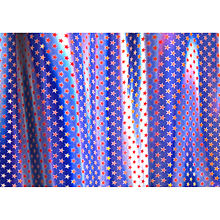From Wikipedia, the free encyclopedia
 An example of a lenticular fabric sheet that changes from a blue background with white stars to a white background with red stars.
An example of a lenticular fabric sheet that changes from a blue background with white stars to a white background with red stars.
A
lenticular fabric
is a lattice-like arrangement of lens-shaped materials formed into a thin layer.
[1]
When the surface of the fabric is smooth, it often has a reflective and light-distorting appearance.
In geology
[
edit
]
Lenticular fabrics are found in nature. Geological forces can produce lenticular fabrics consisting of quartz "microlenses" in clay deposits.
[2]
[3]
[4]
In biology
[
edit
]
Lenticular fabrics can be created through biological processes. For example, termites create these fabrics by combining sand with fibrous faeces to create plastic-like translucent barriers.
[5]
[6]
Technology
[
edit
]
Manufactured lenticular fabric is used to make movie projection screens, so that the image will appear sharper and brighter.
[7]
Lenticular fabric is often used for decorative purposes. It is typically made from PVC with an interlaced
lenticular image
covered in a
lenticular lens
and has a variety of uses, including sewing clothing and craft projects, such as scrap-booking. The lenticular lens on lenticular fabric leads to a variety of effects, such as flip effect of images, 3D-depth, color-changing, motion, morph, zoom, explosion, etc.
[8]
[9]
Lenticular fabric has been utilized in clothing and accessories to create animated imagery and 3-D effects by fashion brands such as
Walter van Beirendonck
,
Miu Miu
, doublet,
Christopher Kane
, and Leeann Huang.
[10]
[11]
Lenticular fabric is used to represent futuristic clothing in films and TV. An example of lenticular fabric appears in the movie,
Back to the Future Part II
, in which Marty McFly wears a lenticular baseball cap.
[12]
References
[
edit
]
Further reading
[
edit
]